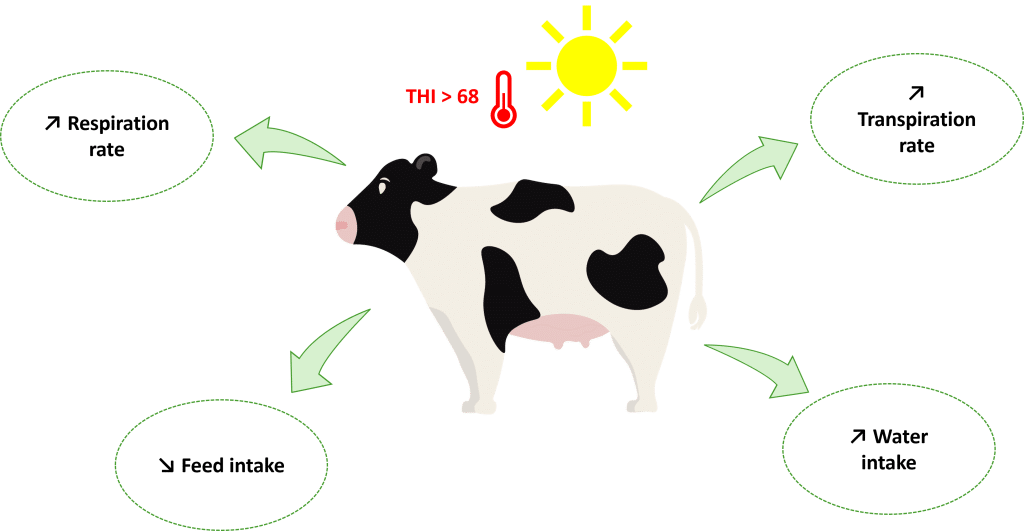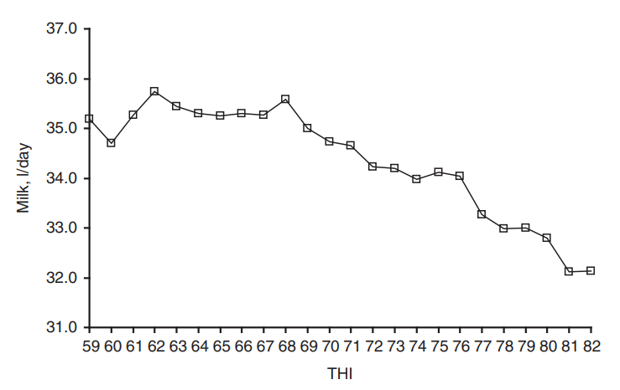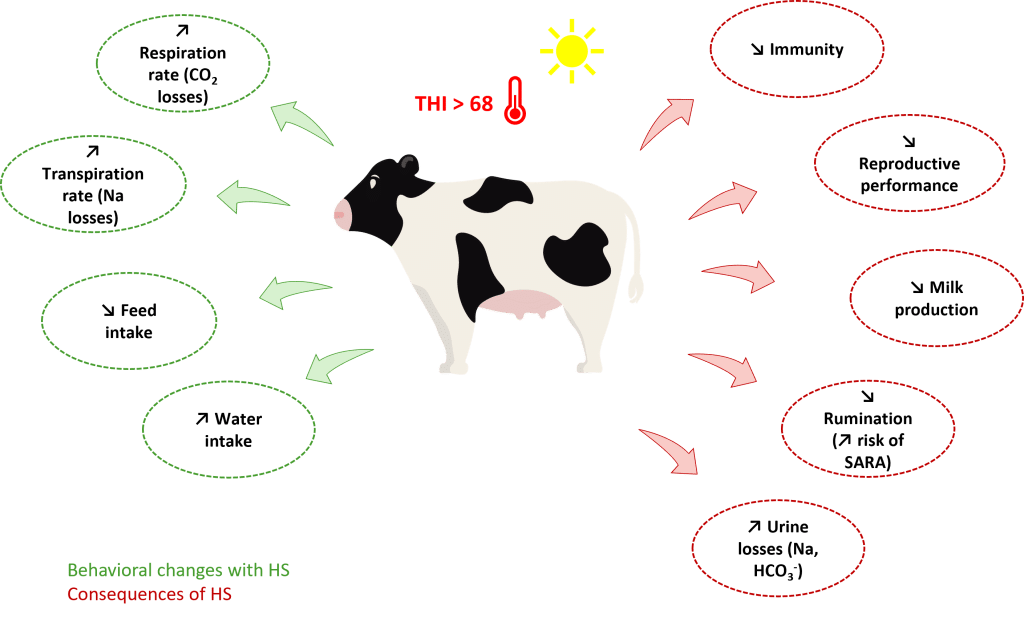With climate change, heat stress episodes are forecast to increase in the next years. As heat stress can have severe consequences on animal health and welfare together with negative impacts on farm performance and economy, animal husbandry needs to adapt itself to this situation.
What is heat stress and how animals try to adapt themselves?
Heat stress (HS) is when conditions of temperature and humidity are too high for animals to dissipate the heat and keep their body temperature at a good level. HS is defined by an indicator, the Temperature and Humidity Index (THI), that is calculated like:
THI ruminant = (1.8 * Tmax + 32) – ((0.55 – 0.0055 * RH) * (1.8 * Tmax – 26.8))
With Tmax, the maximum temperature measured (°C) and RH, the relative humidity (%) (Lallo et al., 2018).
A THI higher than 68 can have consequences on the animal, this is HS conditions. There are different levels of HS that animals try to adapt with different strategies to decrease heat production and increase heat loss. With HS, it is possible to observe some changes in animal behavior like higher water intake, higher sweating and respiration rates or lower feed intake (Figure 1).

Figure 1. Behavioral changes during heat stress.
What are the consequences of heat stress on the animals?
Heat stress has consequences on animal welfare, health and performances that also lead to economical loss for the farm ($1.2 billion of annual profit loss for the US dairy sector (Becker et al. 2020)).

Figure 2. Impact of THI on milk production in Holstein cows (Bernabucci et al., 2010).
1. Impact on rumen health and animal performances
Rumen pH is impacted by HS through intensified respiratory rate and lower feed intake. Indeed, intensified respiration rate lowers blood pH by increasing CO2 excretion. It can lead to metabolic acidosis that the animal tries to manage with higher excretion of sodium (Na) and bicarbonate ion (HCO3–) by the kidneys. However, if more HCO3– is excreted in urine, there is less stock to synthetize saliva. As saliva is a natural rumen buffer, rumen pH decreases. Adding to this, lower feed intake causes a drop in rumination that also induces less salivary production. Then, there is a higher risk of ruminal acidosis, that is well known to affect rumen activity. Within sub-acute ruminal acidosis (SARA), fiber digestibility is also less efficient. Population of cellulolytic bacteria, that digest fibers, drops with a pH lower than 6 leading to low feed efficiency. As a proof of decreased rumen activity, volatile fatty acids (VFA) production is less important. As VFA shape milk production and quality, this situation can lead to production shortage and economic losses. According to Bernabucci et al. (2010), milk production can decrease by 0.27kg per unit of THI if Holstein cows face a THI>68 (Figure 2).
Becker et al. (2020) also reported impacts of HS on milk quality as somatic cells count increases with the THI and milk fat and protein decrease.
2. Impact on reproductive performances
Lower feed intake combined with maintenance requirements that can increase by 7 to 25% during HS (Becker et al., 2020) can impact reproductive performances. Indeed, dry matter intake that declines is not enough to cover the increased nutrients requirement of the animal. We talk about negative energy balance, which is known to affect the reproductive efficiency especially with fresh cows. Moreover, altered endocrine status during HS also explains impaired reproductive performance, including by compromising oocytes growth (Bernabucci et al., 2010). Shorter and less expressive estrus is also a consequence of HS on estradiol secretion that leads to less successful reproduction. All of this accounts for a worse conception rate during heat stress that can decrease by 20 to 27% (Bernabucci et al., 2010). Researchers also observed more embryo mortality with heat stress (Bernabucci et al., 2010).

Figure 3. Behavioral changes and consequences of heat stress
How to manage heat stress?
Several HS management strategies based on thermal comfort (cooling systems, shade providing) and feeding practices (management, diet composition) can be settle.
1. Adapting starch and fiber levels to compensate lower feed intake
It is recommended to feed less fiber (with minimum 28-30% NDF in the diet) and higher energy feeds like grains, fats or sugar (with maximum 26-28% of dry matter (DM) of starch in the diet) to keep a good energy supply despite the decreased feed intake.
2. Importance of feeding a buffer solution
As fiber content decreases and starch content increases to meet the needs of animals eating less, rumen pH is likely to decrease, the risk of SARA is higher. SARA affects rumen microflora, especially cellulolytic bacteria population that drops, leading to lower rumen activity and fiber digestibility. SARA is responsible for milk or meat production decline. Thus, it is critical to add a buffer solution to maintain rumen pH and keep a good rumen health and activity.
3. Adjusting mineral supply
Mineral loss through sweating and urine is more important in heat stressed animals so it is necessary to adapt their mineral supply. Given that, sodium (Na) and potassium (K) supply especially need to be increased to 0.4-0.6% of DM for Na and 1.5-1.6% of DM for K (Akins and Schmidt, 2021). Magnesium (Mg) should also be increased to reach 0.35-0.4% of DM (Akins and Schmidt, 2021) because of the interaction between its absorption and K concentration (the less K, the lower Mg absorption). It is important to maintain good Na and K levels to keep a positive dietary cation-anion difference (DCAD). The DCAD is an indicator which characterizes the acid-alkaline status of the animal. The DCAD of a feed or a diet represents its “acidifying” or “alkalizing” potential. It is expressed in mEq/kg of dry matter and is calculated with sodium (Na), potassium (K), chlorine (Cl) and sulfur (S) ions contents:
DCAD = [K+ + Na+] – [Cl– + S2-] = 1000 * (K/39 + Na/23 – Cl/35.5 – S/16).
As K and Na are alkalizing (they increase the DCAD), they can increase blood pH and then counter the acidification induced by CO2 loss from higher respiration rate during HS. That is why DCAD management is fundamental in case of HS. It is recommended to have a DCAD around 300-400 mEq/kg of DM during HS to maintain a good metabolic acid-base balance and positively impact water and feed intakes.
Phosphea’s solutions to manage dietary DCAD and ruminal pH
Let’s discover Phosphea’s solutions that provide advantages during HS: MSP (MonoSodium Phosphate) and CALSEAPOWDER Advance (CPA).
- MSP provides highly available phosphorus and sodium without chloride and brings a positive DCAD to the formulation.
- CPA is a buffer solution that stabilizes ruminal pH progressively and on a long-term. It ensures rumen productivity and feed efficiency and improves animal performances.

